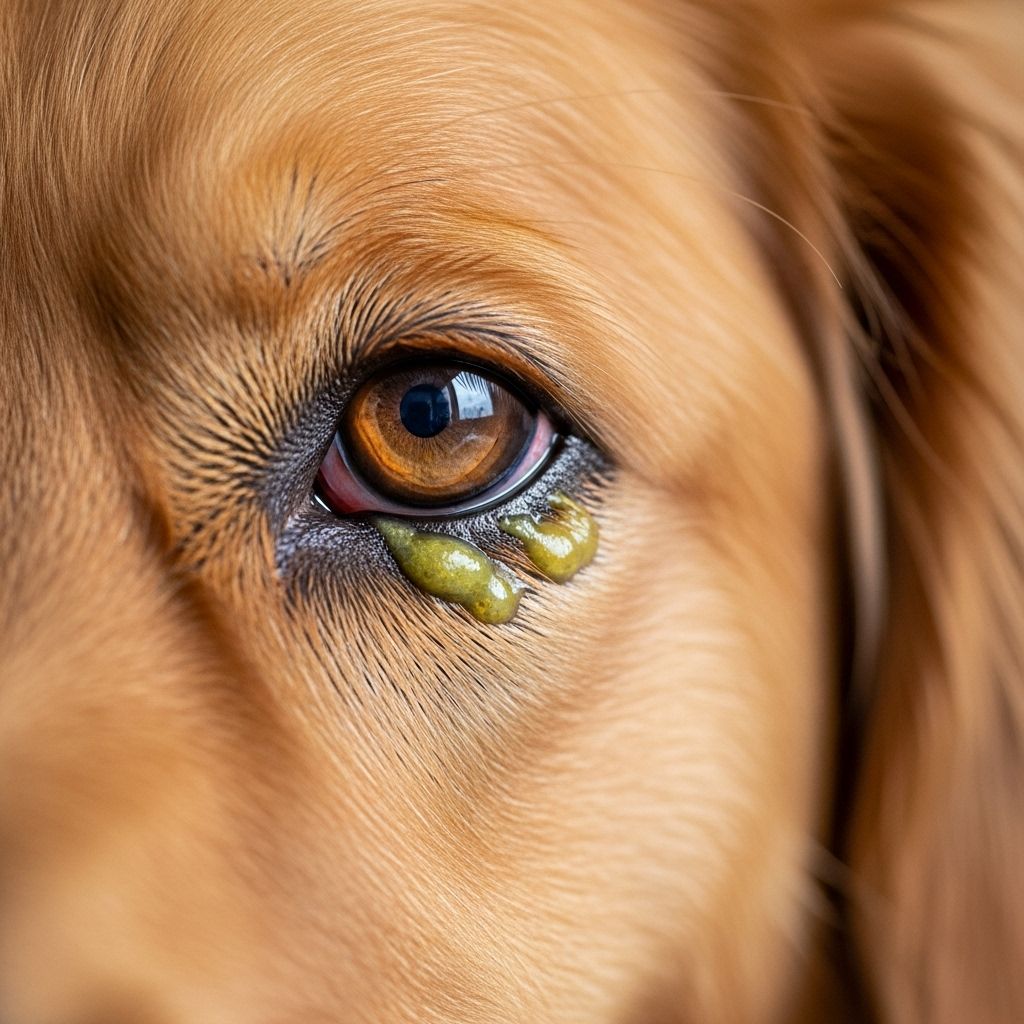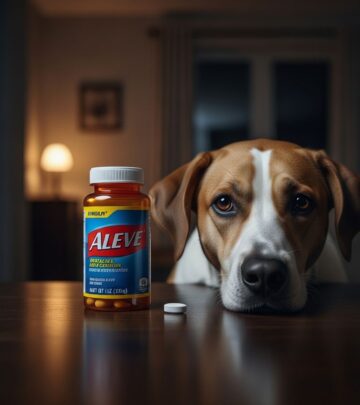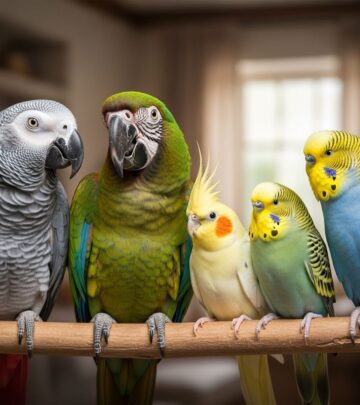Dog Eye Discharge: 5 Types, Causes, And When To See The Vet
Learn about the different types of dog eye discharge, what they mean, and when your pup needs veterinary care.

Image: HearthJunction Design Team
Dog Eye Discharge: Causes, Types, and When to See the Vet
Eye discharge in dogs is a common concern that many pet parents encounter. While certain types of eye discharge are harmless, others can be signs of significant health issues requiring prompt veterinary attention. In this comprehensive guide, you will learn about the various types and causes of dog eye discharge, how to distinguish between normal and concerning symptoms, and effective ways to care for your dog’s eyes.
Table of Contents
- Common Types of Dog Eye Discharge
- Causes of Eye Discharge in Dogs
- When to See the Veterinarian
- Treatment and Home Care
- Prevention and Eye Care Tips
- Frequently Asked Questions (FAQs)
Common Types of Dog Eye Discharge
Understanding the different types of eye discharge helps determine whether your dog’s symptoms are normal or may signal a more serious condition. Here are five of the most common types:
- Clear and Watery Discharge: Usually occurs due to mild irritation, allergies, or exposure to wind and dust. Occasional watery discharge can be normal, especially in certain breeds.
- White or Grayish Mucus: This kind of stringy discharge is often associated with dry eye (keratoconjunctivitis sicca) and can indicate the eyes are not producing enough tears.
Dry eye leads to inflammation and increased mucus production, sometimes causing sticky buildup around the eyes. - Yellow or Green Discharge: A yellow or green tint typically signals an eye infection. Other signs include redness, swelling, and discomfort. This requires prompt veterinary evaluation, as infections can occur alone or as a result of another condition like corneal wounds or dry eye.
- Brown Tear Stains: Rust-colored stains just below the eyes, most visible in light-coated breeds (like Maltese or Shih Tzus). These are usually a cosmetic issue caused by
tear pigment (porphyrin) and can sometimes be worsened by excessive tearing, shallow eye sockets, or hair rubbing against the eye. - Crusty or Thick Discharge: Dried accumulations of discharge can be normal in small amounts (often overnight), but excessive crusting may point to a problem.
Causes of Eye Discharge in Dogs
There are many potential reasons your dog’s eyes may produce discharge, ranging from benign to serious. Here are some of the most common causes:
- Allergies: Seasonal pollen, dust, dander, and other allergens can irritate a dog’s eyes, causing them to become red, itchy, and watery. Dogs may also paw at their eyes or rub their face on the floor.
- Bacterial and Viral Infections: Infections typically cause yellow or green, sticky discharge, often accompanied by redness and swelling.
- Dry Eye (Keratoconjunctivitis Sicca): This condition results from insufficient tear production, leading to inflammation and thick, sometimes sticky, discharge.
- Conjunctivitis: Also known as “pink eye,” this can be caused by infection, allergies, irritants, or other underlying eye diseases. It often results in red, swollen eyes with mucus or pus-like discharge.
- Foreign Bodies: Dust, dirt, or other small particles can enter the eye, triggering a protective watery discharge or even more severe irritation.
- Injury or Trauma: Scratches, abrasions, or blunt trauma can lead to increased tearing and discharge as the eye tries to heal itself.
- Breed-Related Anatomy: Breeds with prominent eyes or shallow eye sockets (such as Pugs, Bulldogs, and Shih Tzus) are more prone to chronic eye discharge due to greater tear exposure and inefficient drainage.
- Eyelid and Lash Abnormalities: Conditions like entropion (where eyelids turn inward) or distichiasis (extra eyelashes) can chronically irritate the eyes, leading to discharge.
- Blockage of the Tear Duct: If the tear duct becomes blocked, tears overflow and cause chronic watery discharge and staining.
- Systemic Illness: Sometimes, what appears as an eye issue may actually be a symptom of broader health problems affecting the respiratory or nervous system.
When to See the Veterinarian
Eye problems can worsen rapidly in dogs, so timely care is crucial. Contact your veterinarian if you notice any of the following signs:
- Yellow or green discharge, especially with redness, swelling, or pain
- Persistent or worsening symptoms after 24-48 hours
- Excessive tearing or thick, sticky eye discharge
- Your dog squints, blinks excessively, or keeps their eye(s) closed
- Visible injury, cloudiness, or change in eye color
- Rubbing at or pawing the eye, showing signs of discomfort
- Swelling of the eyelids or tissue around the eye
Never ignore sudden, severe changes in your dog’s eye appearance or behavior. Eye infections, ulcers, and injuries can progress quickly and may lead to permanent damage or vision loss without prompt treatment.
Treatment and Home Care for Dog Eye Discharge
The most effective way to manage your dog’s eye discharge depends on identifying and treating the underlying cause. Here are the typical steps and recommendations:
How Veterinarians Diagnose Eye Problems
- Physical examination of the eye and surrounding tissues
- Staining tests to check for corneal ulcers or abrasions
- Tear production testing (Schirmer tear test for dry eye)
- Culturing discharge for infection identification
Common Treatments
- Antibiotic or Antiviral Drops/Ointments: Used for bacterial or viral infections
- Lubricating Eye Drops: Relieve symptoms of dry eye or irritation
- Anti-inflammatory Medications: Reduce swelling and discomfort
- Surgical Correction: Necessary for anatomical problems like entropion or blocked tear ducts
- Allergy Management: Includes antihistamines, avoiding triggers, or immune-modulating medications
At-Home Care Tips
- Gently wipe away discharge with a clean, damp cloth or pet-safe eye wipes
- Never share eye medications between pets or use human products unless directed by your veterinarian
- Keep hair around the eyes neatly trimmed (if advised by your vet)
- Monitor for new or worsening symptoms
Prevention and Eye Care Tips
- Inspect your dog’s eyes daily for redness, swelling, or abnormal discharge
- Keep the eye area clean and free of debris
- Schedule regular veterinary checkups and address eye concerns promptly
- Prevent injuries by keeping dogs away from rough play, thorny bushes, or hazardous environments
- Be alert to seasonal allergy triggers and environmental irritants
Breed Predispositions for Eye Discharge
Certain breeds are more prone to eye issues:
- Brachycephalic breeds (Pugs, Bulldogs, Shih Tzus): Shallow eye sockets, exposed corneas, and poor tear drainage can lead to chronic discharge
- Maltese, Poodles, Cocker Spaniels: Prone to tear staining and dry eye
Frequently Asked Questions (FAQs)
Should I be concerned about my dog’s eye discharge?
If your dog exhibits green or yellow discharge, notable redness, or seems to have eye discomfort (e.g., rubbing, pawing, squinting), prompt veterinary care is recommended. While mild, clear discharge can be normal, colored or persistent discharge is often a sign of infection or inflammation that requires medical attention.
How do I get rid of my dog’s eye discharge?
Treating your dog’s eye discharge starts with diagnosing the cause. Consult your veterinarian for a tailored treatment plan. At home, you can gently clean away discharge with pet-safe wipes or a damp cloth, but never use human eye medications or apply home remedies without veterinary guidance.
Can I prevent my dog from developing eye discharge?
While not all causes are preventable, you can minimize risks with regular eye checks, hygiene, and by addressing environmental allergens or irritants. Early veterinary intervention at the first sign of trouble can prevent serious complications.
Are eye problems in dogs contagious?
Some infections (especially viral and bacterial conjunctivitis) can be contagious to other dogs. Always wash your hands after handling a dog with eye symptoms and keep affected pets separated if recommended by your veterinarian.
When is dog eye discharge an emergency?
If your dog suddenly develops severe redness, swelling, vision loss, bleeding, or is in significant pain, seek emergency veterinary care immediately. Eye emergencies can deteriorate quickly and may threaten vision or overall health.
Quick Reference Table: Dog Eye Discharge Types and What to Do
| Type of Discharge | Possible Cause | Action Needed |
|---|---|---|
| Clear, watery | Irritation, allergies, breed anatomy | Monitor, manage allergies, veterinary check if persistent |
| White/gray, stringy | Dry eye | Vet evaluation; may need lubricating drops |
| Yellow/green, thick | Infection (bacterial/viral), injury | See vet urgently |
| Red-brown stains | Excess tearing, shallow sockets, hair irritation | Usually cosmetic, vet if excessive or new |
| Crusty buildup | Normal (minor), or sign of infection if excessive | Gently clean; check with vet if persistent |
Key Takeaways
- Most dogs have some eye discharge, but yellow/green, persistent, or painful discharge signals a problem.
- Common causes include allergies, infections, dry eye, injury, breed traits, and foreign bodies.
- Consult a veterinarian promptly for colored discharge or if your dog is uncomfortable.
- Quick action can prevent complications like corneal ulcers, scarring, or vision loss.
For any concerns regarding your dog’s eye health, always rely on your veterinarian’s advice for diagnosis and treatment tailored to your pet’s needs.
References
- https://www.webmd.com/pets/dogs/dog-discharge-from-eye
- https://www.petmd.com/dog/general-health/dog-eye-discharge
- https://thevets.com/resources/pet-symptoms/dog-eye-discharge/
- https://www.reedanimalhospital.com/blog/five-types-of-dog-eye-discharge-meaning/
- https://www.allaboutvision.com/eye-care/pets-animals/eye-discharge-dogs/
Read full bio of Anjali Sayee












